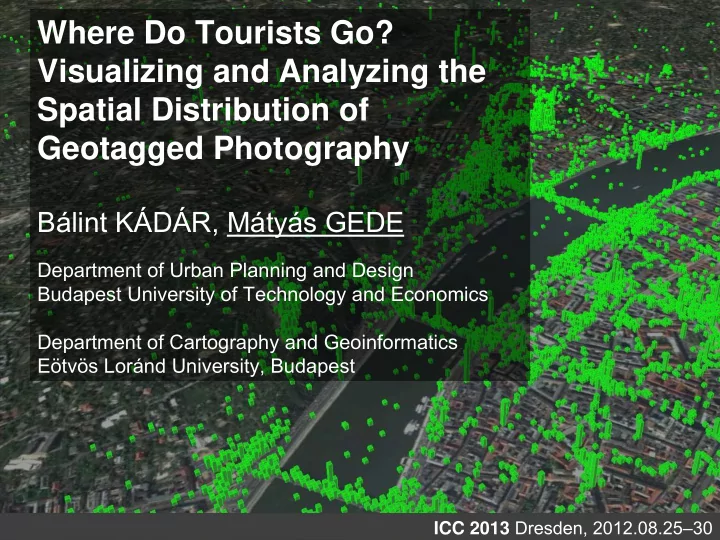

Where Do Tourists Go? Visualizing and Analyzing the Spatial Distribution of Geotagged Photography Bálint KÁDÁR, Mátyás GEDE Department of Urban Planning and Design Budapest University of Technology and Economics Department of Cartography and Geoinformatics Eötvös Loránd University, Budapest Kádár & Gede: Where do tourists go? – ICC 2013 Dresden, 2012.08.25–30 – 1/15 ICC 2013 Dresden, 2012.08.25–30
Outline -Aims -But what makes a photo „geotagged”? -Data collecting through photo sharing APIs -Visualization, analysis -Discussion -Further possibilities Kádár & Gede: Where do tourists go? – ICC 2013 Dresden, 2012.08.25–30 – 2/15
Aims: Collecting and analyzing information from geotagged photos for… -Providing information about tourists’ spatial distribution in cities based on geotagged photography -Analyzing the behavior of short-term and longer staying visitors -Verifying the impact of urban developments Kádár & Gede: Where do tourists go? – ICC 2013 Dresden, 2012.08.25–30 – 3/15
But what makes a photo „geotagged”? Geotag = geographic positional information Sources of position data: - Cameras with GPS device - Smartphones (using GPS / WiFi / GSM position info) - Separate GPS device, geotags are merged into images using a special SW - Geotagging while uploading photos to photo-sharing sites Geotagging is popular : more than 25000 photos at Budapest in one year (on Flickr) Kádár & Gede: Where do tourists go? – ICC 2013 Dresden, 2012.08.25–30 – 4/15
Data collecting through photo sharing APIs Some services provide an API (Application Programming Interface) - operating via HTTP requests - providing attributes of photos taken within a given quadrangle (specified by boundary latitudes/longitudes) - limited amount of data per request (e.g. max 250 photos at Flickr) Due to the limitations it is advisable to store the data in a database for further analysis data photo request collector sharing response application API photo data background DB Kádár & Gede: Where do tourists go? – ICC 2013 Dresden, 2012.08.25–30 – 5/15
Flickr vs. Panoramio Panoramio no registration undocumented filtering -> contradictory results Flickr requires registration (free of charge) downloaded data more reliable Kádár & Gede: Where do tourists go? – ICC 2013 Dresden, 2012.08.25–30 – 6/15
Visualization #1: raw data Let’s place a dot at each photo’s location! Kádár & Gede: Where do tourists go? – ICC 2013 Dresden, 2012.08.25–30 – 7/15
Analyzing data useful attributes: - location - date of photo - owner ID Example: if the date difference of a user’s first and last photo within a given area is greater than 5 days, the user can be considered as a local it that area. Otherwise, the user is a visitor there. Results (at Budapest): Most visitor photos are concentrated Local photos also include touristic around touristic highlights (Castle highlights, but there are several Hill, Danube Bank and bridges, Par- pictures scattered at residential areas lament, St. Stephen’s Basilica, And- and large number of photos at pubs, rássy Avenue, Heroe’s Square etc.) sport fields / stadiums, universities etc. Kádár & Gede: Where do tourists go? – ICC 2013 Dresden, 2012.08.25–30 – 8/15
Visualization #2: 3D bars Let’s place a grid to the map of the examined area and calculate the number of photos in each grid cell. The results can be visualized as 3D bars on a digital globe (e.g. in Google Earth). Kádár & Gede: Where do tourists go? – ICC 2013 Dresden, 2012.08.25–30 – 9/15
Visualization #2: 3D bars Changing tourist timespan limit Kádár & Gede: Where do tourists go? – ICC 2013 Dresden, 2012.08.25–30 – 10/15
Visualization #2: 3D bars Differences of local/tourist pattern and impact of new developments Kádár & Gede: Where do tourists go? – ICC 2013 Dresden, 2012.08.25–30 – 11/15
Visualization #3: Difference map Difference maps showing whether the local or tourist photos are in majority, or their number is similar. The grid cell size is doubled on the right-side map to demonstrate the importance of grid granularity. Kádár & Gede: Where do tourists go? – ICC 2013 Dresden, 2012.08.25–30 – 12/15
Discussion Number of days instead of total timespan: - ~17% difference - repeated visitors tend to act like locals User count instead of photo count: - correlates more to the number of visitors - correlates less to the atractiveness of the place Grid size: 10m*10m - more or less equals to GPS position error - smaller than urban features (houses, places etc.) → photos within a cell are at the same place Kádár & Gede: Where do tourists go? – ICC 2013 Dresden, 2012.08.25–30 – 13/15
Further possibilities - temporal analysis: - photo distribution before and after a specific urban development (e.g. a new pedestrian zone) - comparing photos taken in summer/winter, working days/weekends, morning/afternoon etc. -movement analysis: generating typical tourist paths -developing additional visualization methods together with the above mentioned analysis. -defining a „touristic graph” of a city by automated spatial clustering of photos Kádár & Gede: Where do tourists go? – ICC 2013 Dresden, 2012.08.25–30 – 14/15
Thank you for your attention! Kádár & Gede: Where do tourists go? – ICC 2013 Dresden, 2012.08.25–30 – 15/15
Recommend
More recommend